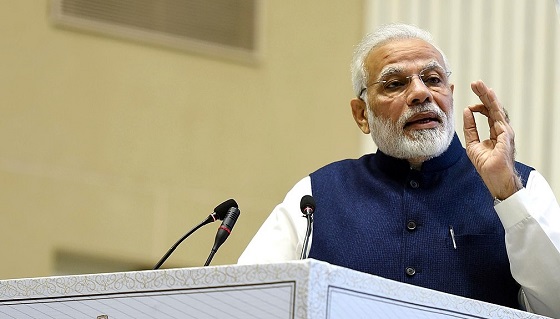Narendra Modi’s India sheds Historic Reservations about the United States
Chilamkuri Raja Mohan
1 March 2020Summary
The unprecedented public welcome given to United States (US) President Donald Trump in India marks an end to India’s traditional political hesitations about engaging the US. Although no major agreements were signed during the visit on 24 and 25 February 2020 and a trade deal remained elusive, the expansive and expressive bonhomie between Trump and Indian Prime Minister Narendra Modi signalled the growing alignment of US and Indian interests in the Subcontinent and the Indo-Pacific.
Few international leaders in recent memory have received a welcome of the kind that United States (US) President Donald Trump did during his visit to India on 24 and 25 February 2020. A roaring 125,000 people packed the Motera Cricket Stadium in Ahmedabad in Gujarat while crowds lined up all along Trump’s route from the airport, where he was received on the tarmac by Indian Prime Minister Narendra Modi himself, to the stadium. The special reception for Trump comes in spite of the fact that none of India’s major power relations have been as deeply contested and controversial as those with the US.
The historic welcome to Trump was organised with great effort by the Modi-led government and the ruling party Bharatiya Janata Party, which also runs the state of Gujarat. The attention and warmth showered on Trump in Ahmedabad and New Delhi mark a definitive turn in India’s thinking about America. Despite much progress over the last two decades, distrust of the US was entrenched in the Indian bureaucracy, political class and intelligentsia.
Modi’s recent predecessors, including P V Narasimha Rao, Atal Bihari Vajpayee and Manmohan Singh, were all eager to transform the relationship with the US but ran into deep internal resistance against even the simplest forms of cooperation with Washington. Security partnership with the US in particular was, by mainstream definition, a deviation from the foreign policy canon of non-alignment. Modi appears to have broken through that systemic prejudice against the engagement with the US.
In his address to the US Congress in the summer of 2016, Modi had claimed that India’s ‘historic hesitations’ with the US were over. If that was a declaration of intent, Motera was a demonstration of that transition. The joint statement on building a “Comprehensive Global Strategic Partnership” suggested that New Delhi is hedging less and tightening its embrace with the US.
The prime minister’s affirmation that the US was the most important relationship for India was based on an important fact highlighted by one fact. As Modi said in his concluding remarks at the public event at Motera, there is a new level of trust between Delhi and Washington. This trust in the US has allowed Modi to publicly flaunt the new possibilities with America.
Modi’s warmth towards Trump looks quite similar to India’s enthusiasm for Soviet Russia during the Cold War. The partnership with Moscow became the anchor of New Delhi’s world view during those decades, because Russia was ready to support India’s core interests on the Kashmir dispute and on the conflict with China.
Trump’s visit should remind us of extended travels through India by the Secretary of the Communist Party of the Soviet Union, Nikita Khrushchev, and Prime Minister Nikolai Bulganin in 1955. As the two Russian leaders travelled across the nation from Ooty in Tamil Nadu to Srinagar in Kashmir, massive crowds showed up everywhere. As Soviet Russia tried to break away from its international isolation in the 1950s, it was moved by the public affection in India. Trump, unloved at home and around the world, appeared touched by the huge turnout at Motera.
Trump’s visit is also similar to Khrushchev’s in the signalling both leaders did on Kashmir. In their public meeting in Srinagar, the Russian leaders proclaimed their strong support for India’s stand on Kashmir at a time when the Anglo-American powers were trying put pressure on India at the United Nations Security Council (UNSC). Nothing developed trust between New Delhi and Moscow more than the frequent Russian veto at the UNSC on Kashmir.
Although the Indian media obsesses about the ‘threat’ of mediation from Trump, the reality has been quite different. New Delhi has, in fact, received extraordinary support from Trump’s White House on the Kashmir question and on pressing Pakistan to stop cross-border terrorism. America’s support was critical in fending off Pakistani effort to get the UNSC to discuss Kashmir after India changed the constitutional status of the state in August 2005. It was also crucial in sustaining the pressure on Pakistan at the Financial Action Task Force. Even more important is Trump’s implicit endorsement of Modi’s recasting of the Kashmir question. Since August 2019, the US has not questioned the constitutional change in Kashmir.
That the American backing has come amidst China’s support for Pakistan on Kashmir and protection against international action on terrorism is one part of the unfolding story of India-US alignment. The other is about China itself. If support on Kashmir brought Soviet Russia closer to India in the 1950s, the rift between Moscow and Beijing in the 1960s consolidated the Indo-Soviet partnership. Today, the deepening schism between Washington and Beijing and the growing imbalance between India and China appears to be setting the stage for joint efforts by New Delhi and Washington to stabilise the Asian balance of power. As Trump put it at Motera, US and India “will defend our sovereignty, security, and protect a free and open Indo-Pacific region for our children and for many, many generations to come.”
. . . . .
Professor C Raja Mohan is Director at the Institute of South Asian Studies (ISAS), an autonomous research institute at the National University of Singapore (NUS). He can be contacted at isascrm@nus.edu.sg. The author bears full responsibility for the facts cited and opinions expressed in this paper.
-
 More From :
More From :
-
 Tags :
Tags :
-
 Download PDF
Download PDF


